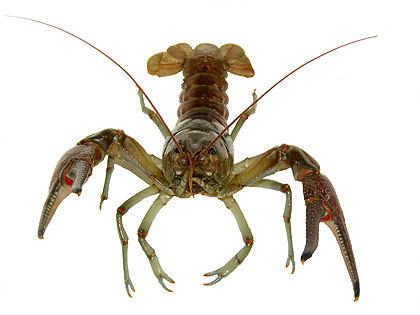Eugene Weekly’s Earth Day Issue:
Carpe the Carp Stalking the elusive *Kentucky tunain Oregon waters
Pretty, Bad Mute swans in Oregonû
Bees, Baby, Baby, Bees Nonnatives make the world go round
Dont Feed the Birds Wild turkeys are really feral
Not So Big, Not So Bad Wolves return to Oregon, cause a ruckus in Congress
Will Work for Food Nonnative earthworms move slow, compost fast
Crawfish, Crawdad, Crayfish Whatever you call them … theyre invading Oregon
Crawfish, Crawdad, Crayfish
Whatever you call them … theyre invading Oregon
By Heather Cyrus
Crayfish, also known as crawfish and crawdads, are freshwater crustaceans resembling small lobsters. People eat crayfish or use them for fishing bait, and kids study them in classrooms.û
According to Robyn Draheim, research assistant for the Center of Lakes and Reservoirs at Portland State University, there is one known crayfish species endemic to Oregon, the signal crayfish, but there are three non-native species competing with the natives for food, shelter and space.û
 |
| Jeff Gunderson |
øThe nonnative crayfish are very aggressive. They take over the burrows of native crayfish, leaving the natives exposed to predators,” Draheim says. The nonnatives are ferocious eaters compared to the natives and can potentially introduce new diseases to the water systems, she adds.
According to Draheim, rusty crayfish, now found in Eastern Oregons John Day River, are native to the Ohio River basin and were brought into Oregon primarily as a bait species. Ringed crayfish, another bait species, are found mainly in the Rogue River to our south. The red swamp or Louisiana crayfish, native along the Gulf coast and introduced commonly as a food source (people order them live to eat), have been found in the Umpqua drainage and in the upper Willamette. û
Although there are no reports yet of nonnative crayfish species documented in Lane County, Draheim says that øundoubtedly they are there, but reporting is inconsistent. Most people see crayfish and thats the end of the story.”
All three nonnative species are used in the biological trade for classroom science kits. Teachers purchase the kits in order for students to study a live animal.û
Although it is illegal to ship nonnative species of crayfish to Oregon, companies are still doing it. Often teachers arent aware of what species they are ordering because the crayfish arent labeled on the websites. The problem arises when the school year is over, and the classroom has a live animal to øget rid of.” Often classes release the crayfish into nearby streams. øFemales can store sperm, so even if you introduce only one crayfish, she can lay eggs and start a new population,” Draheim explains.
One company attempting to eradicate this problem is Mountain Home Biological in White Salmon, Wash. The company has been offering the native signal crayfish for sale, but not without complications. øThey are harder to keep alive, harder to get a hold of and are not as successful as the red swamp crayfish, but we are trying,” said Rick Bretz, operations manager for Mountain Home Biological.û
Draheim agrees that the signal crayfish arent as hardy as the nonnatives. They dont stand up to all the holding and examining the children do in the classroom, and sometimes die before the class is done with its study.û
øAlthough it hasnt been easy, we want to do the right thing,” Bretz said. Mountain Home Biological won the Oregon Invasive Species Councils Invader Crusader award Feb. 22, 2011 for its efforts in providing native crayfish for sale.
Draheim says there are no effective ways of eradicating the nonnative crayfish once they enter a stream or river, and the future effect of that species on the region is hard to predict.
Crayfish arent Oregons only stream invaders. The Oregon Department of Fish and Wildlife lists the American bullfrog, Asian carp, Chinese and Japanese mystery snails, Chinese mitten crab, common snapping turtle, New Zealand mud snail, northern snakehead, oriental weatherfish, red-eared slider, and the zebra and quagga mussels alongside crayfish as its top invasive water worries.